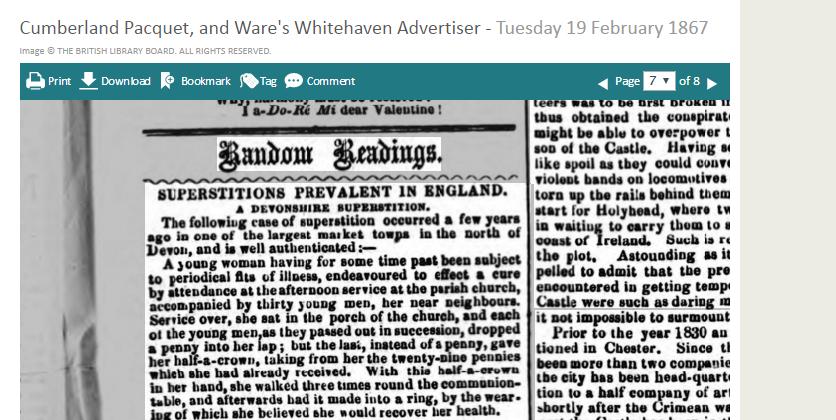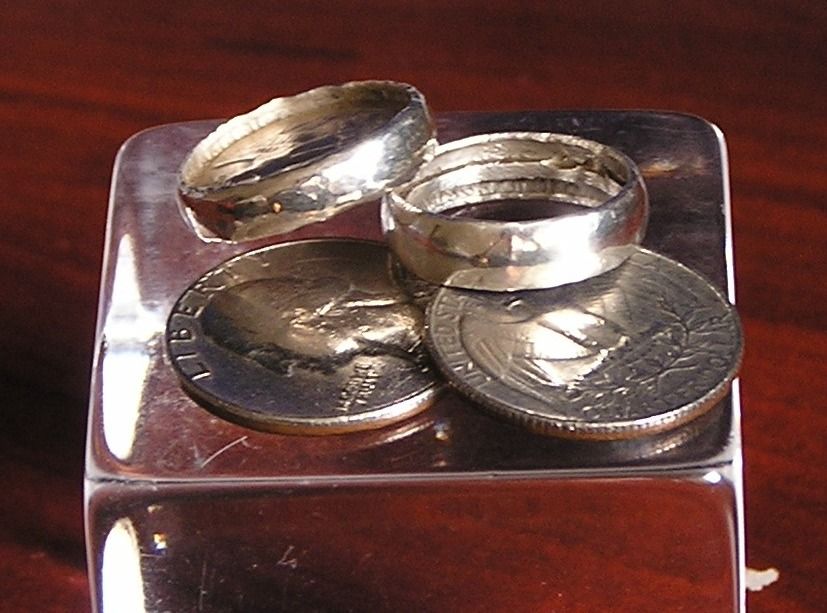The Most Beautiful Folk Cure: An Epilepsy Ring February 25, 2014
Author: Beach Combing | in : Modern , trackback***for Tacitus on sabbatical***
There is a little to be said for many folklore cures in terms of efficacy unless we call out placebo. However, some cures are winners, even spectacular winners in an aesthetic sense. I recently ran across this very curious nineteenth-century Welsh cure for epilepsy (‘the cure of fits’): it appeared in a newspaper in 1883 and Anglesey is the island off the north coast of Gwynedd, once the grain basket of the last of the British Romans. Now there will be those who get all lyrical about a community effort and, for all we know, the effect of badly melted silver leaching into the skin. But I just like it in terms of the cure’s poetry: so enjoy this little drop of Welsh wisdom and can anyone else offer any equally lovely folk cures? drbeachcombing AT yahoo DOT com So much better, anyway, than throwing urine in people’s faces (Cork cure for changelings) or passing a child under a donkey (Irish help for hooping cough) or, for that matter, scratching someone’s face with a bramble till it bleeds (classic English preventative against witchcraft).
An extraordinary superstition exists in Anglesey with regard to the cure of fits. All that is required, according to the belief of the peasantry, is to beg twelve pennies from twelve different persons, keeping the reason for begging them secret. The coppers are then to be exchanged for a shilling, and sent by a person (ignorant of the cause of his or her mission) to a silversmith to be made into a ring. The latter is afterwards worn by the afflicted one, and the fits disappear as if by magic. A ring was made under such circumstances in Bangor, the other day, by Mr Welch. (1883)
You would have expected a late Victorian to get a little hot under the collar about the fact that the queen’s currency is being melted down here, but not a bit of it: the inherent interest of the cure held our correspondent’s outrage at bay. The usual cure for epilepsy involved, of all things, coral in the early modern period. There is some muttering though about iron (apparently the nail from a crucified person helped in ancient times) and even a silver medallion with the magi written on: late antique? The only real parallel is one cure with thirty pennies from thirty different people strung together on a ribbon to be worn around the neck: still I prefer the Anglesey version.
28 Feb 2014: Invisible sends in this beaut: Another mode of cure for this scourge of childhood [whooping-cough] prevails in the North of Ireland. A lady residing in the county of Derry, my own near relation, tells me that a short time ago her servants summoned her out of doors to see a stranger who was peering about in the yard but would not speak to any of them. She went and found a respectable middle-aged woman, apparently a farmer’s wife, who, seeing her to be the mistress of the house, eagerly went up and prayed her to save her child. In answer to the lady’s inquiries the woman said, “My child is dying of whooping-cough; the doctors can do nothing more, so I went to a skilled man, and he told me to fill a small bottle with milk and take it to a house I had never visited before. I must cross the water three times to get to it, and must speak no word by the way till I see the master or the master’s wife of this strange house. Then I must tell my tale and ask whether they keep a ferret. If they do I must pour the milk in a saucer, see the ferret drink half of it, return the other half into the bottle, take it home and give it to the child. He will drink it and be cured at once. Now I see you have ferrets, let me have one at once. I have been out so many days and have not been able to find a strange house where they kept them.” My friend, as kindly as she could, endeavoured to disabuse the poor woman’s mind of this strange superstition, but a belief in it was deeply rooted in her mind. Since I received this narration I find that something similar holds its ground in my own county. The following instance was communicated to me by the late Rev. J. W. Hick, of Byer’s Green: “A boy came into my kitchen the other day with a basin containing a gill of new milk, saying his mother hoped I would let my son’s white ferret drink half of it, and then he would take the other half home to the bairn to cure its cough. I found the boy had been getting milk in the village for some days, and thus giving our ferret half of it.” thanks Invisible!
Notes on the Folk-lore of the Northern Counties of England and the Borders, William Henderson.
Henderson also collected several variants of the coins-melted-into-a-ring charm you cited: a half-crown from an Offertory collection, seven sixpences from seven maidens in seven villages, etc.
4 May 2016: More on this from June.




